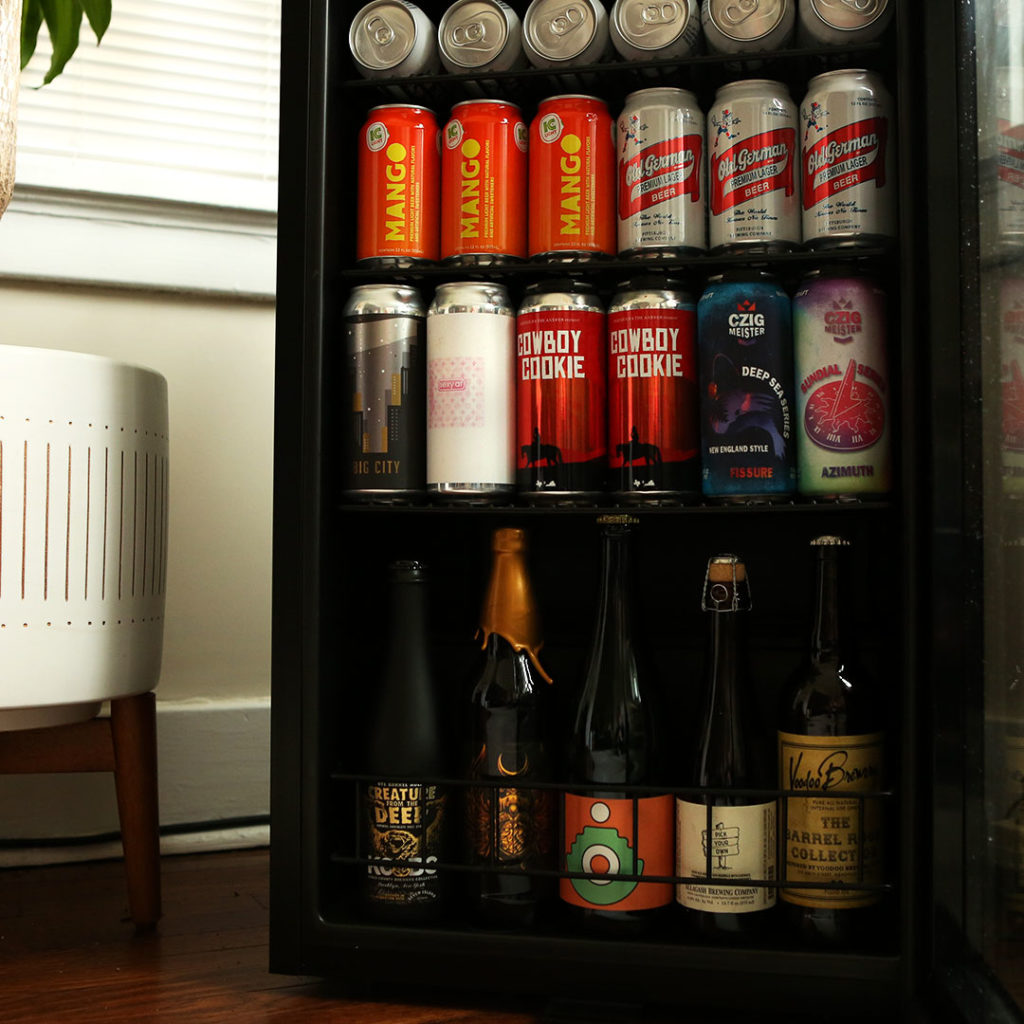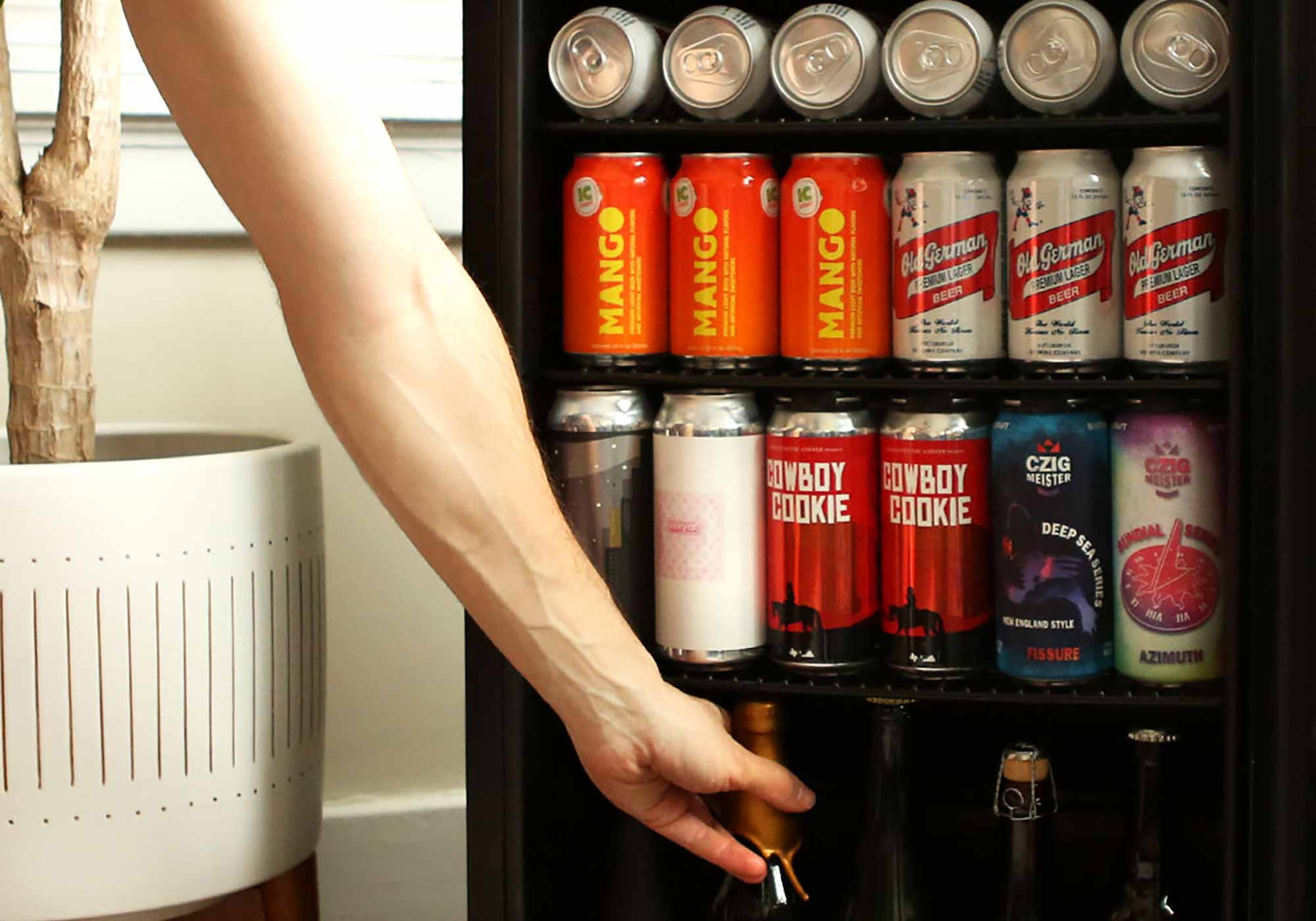This content was originally published by The Hop Review, a digital magazine that joined the Hop Culture family in March 2020.
This piece was written by Jack Muldowney.
UPDATED: 1/24/24
When it comes to beer, one of the most important things to get right is temperature. After all, there’s nothing sadder than an otherwise perfect brew ruined by less-than-ideal serving conditions. The best bartenders and brewpub managers have this down to an art, of course. But what’s a dedicated beer drinker to do with all those bottles at home? What’s the best way to store beer?
After all, you should have the same great flavor experience at your house as you do from your favorite tap. That’s why we created this guide on how to store beer at home.
Proper beer storage is the key to a great drinking experience, and the right storage temperature will make any beer taste its best. Here’s what you need to know to get the maximum flavor out of everything from a barleywine to a Budweiser.
How To Store Beer — The Basics

Most craft brewers work really hard to get the perfect balance of flavors and aromas into the bottle and ship it out for drinking within a few months of purchase. While it’s totally possible to “age” a beer by cellaring it like wine, it’s not always necessary.
So when we talk about storing beer, we want to keep it fresh for its recommended shelf life. That’s typically a couple of months at most, though some styles can last for a couple years if stored well.
What’s The Best Way To Store Beer?
To prevent flavor loss and make sure your beer tastes exactly like it should, you should keep the bottles at a steady 50 to 55 degrees Fahrenheit. This is known as the “cellar temperature,” though you don’t need to have a cave in your basement to make this work. In fact, any well-designed beer fridge will allow you to keep the temperature in this range. A good beer fridge will also protect the bottles from damaging UV rays.
One quick note — many people will advise storing beer upright for long periods of time (cellaring) to prevent leaking or yeast buildup on the vessel’s wall. However, other than those rare occurrences, storing beer horizontally won’t ruin your favorite brew.
Should I Store Beer At Room Temperature?
Did you notice that we’re not recommending any beer be stored or served at room temperature? That’s because, as modern people, we have pretty high expectations for comfort, and room temperature has crept up over the years. You probably keep your living room at around 72 degrees. For brewers in the Middle Ages, that’s positively balmy!
Because of this, it’s no longer accurate to say that a beer is best stored or served at room temperature, unless you live in an igloo. Keep your beers chilled to an old-fashioned beer cellar temperature — usually about 50 degrees year-round -— and you’ll be much closer to the mark.
It’s also good to remember that your beer will warm up gradually as it sits in the glass. To allow for a longer sipping session, it makes sense to pour it on the colder end of your preferred range so you can enjoy it as it slowly warms. Real beer geeks will note the changes in flavor as this happens. And if you take notes, you can adjust your storage temperature to keep any beer at your preferred temperature. We call that the perfection point, and it’s definitely within your reach when you know what you’re doing.
What’s The Ideal Temperature To Store And Serve Beer?
Keeping all your beer chilled to at least 50 or 55 degrees will allow it to stay fresh for a good long while, but that’s not necessarily the optimum temperature for drinking. To get the full experience, you need to have the right balance of cool refreshment and the warmth that brings out the delicate balance of flavors and aromas.
Freezing your tongue with an over-iced beer will kill your ability to enjoy it as it was meant to be tasted. So what’s a beer aficionado to do?
We think it’s easiest to store beer at the same temperature you wish to serve it so that it’s ready whenever you are. This is easily managed by adjusting the temperatures on your beer fridge based on the style of beer you keep in it.
One of our favorite beer fridges is the NewAir Beverage Cooler. While the slatted shelving doesn’t play as nicely with smaller formats (12oz cans and such), it was worth the trade-off to house our entire collection.
An Easy Guide To Beer Serving Temperatures
We’ll start with the beers that taste best ice-cold and move into warmer climates (all discussed in terms of Fahrenheit, of course).
35 to 40 Degrees (Macros)
This is very cold—almost tongue-numbing. The only beers that you should keep on ice or in your food fridge are mass-market drinks like Bud and Coors. This also works for non-alcoholic beers, too. We’re not saying that you need to deaden your taste buds to drink these beers, but we’re not not saying that, either.
40 to 50 Degrees (Wheat Beers & Pilsners)
This is still noticeably cold, but it’s not icy. This temperature is for light-bodied wheat beers and German pilsners that are meant to go down easy. Cold temperatures also make sense for craft beers with fruit flavors—think summer specials. You could also chill a pale lager to this level, but be careful not to go too cold or you might flatten out the complexity.
45 to 50 Degrees (IPAs & Lagers)
IPAs of all nationalities belong in this temperature range. The colder the temperatures, the more bitterness you’ll taste, be careful. If you’re storing an extra-hoppy pale ale, you’ll want to serve it on the warm end of this range. (Of course, if you love the pucker, you can adjust to your own taste.) Many lagers do well in this range, too.
45 to 55 Degrees (Porters & Stouts)
Porters and stouts usually present a balanced flavor profile that blend the bitterness of hops with the sweetness of malt. These brown beers also tend to have a higher alcohol content, which means you can store and serve them at higher temperatures than an IPA — but they should be well under room temperature.
50 to 55 Degrees (Sours & Bocks)
As a rule of thumb, ales should be served warmer than lagers to allow all their complexity to come through on the palate. This includes sour ales and bocks. They have an even higher alcohol content and can therefore stand up to storage at 55 degrees without off-flavors.
55 to 60 Degrees (Barleywines & Strong Ales)
High-alcohol beers like strong ales, imperial stouts and barleywines can last for years without much chill—it’s what they were designed to do in the days before refrigeration. They are best served just slightly under room temperature.





